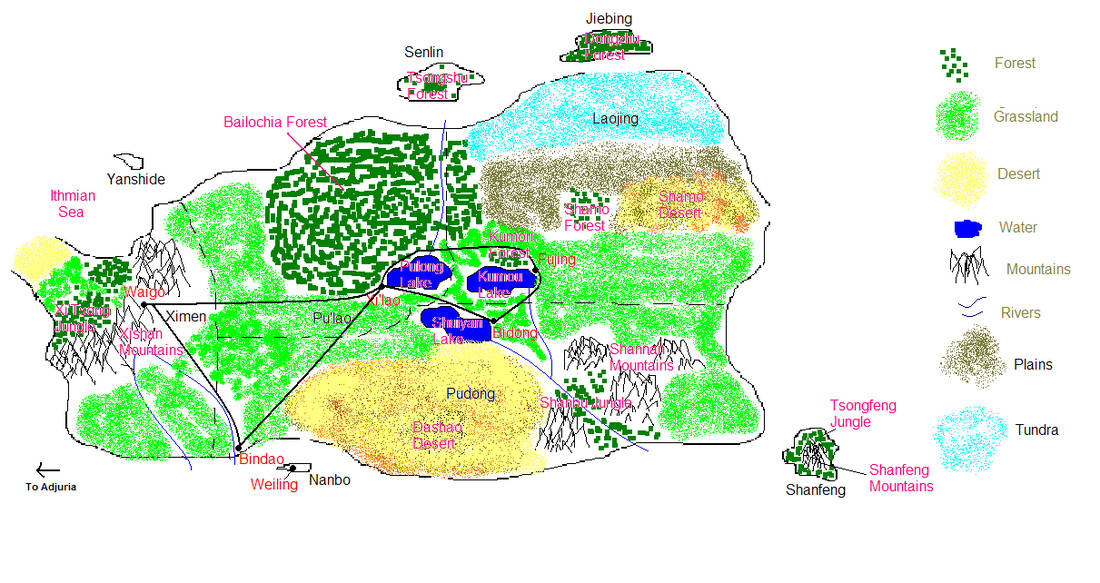In the last post I discussed how important it is to create a detailed fantasy world that will allow your characters to have rich and varied histories. This comes in handy when you’re showing your readers the experiences, motivations, and rationale for your characters. In other words it does a lot to pu all that emotional glue into place that holds your story together.
I showed concrete examples of how to create a fantasy world that sells by profiling my own fantasy world which my reader’s were introduced to with The Jongurian Mission.
Defining Your Groups
However, there are both good and bad elements present in people from both areas, and sometimes they even act to further the other groups’ ends.
Here is what I did when defining my second group, the antagonists:
East
- Jonguria has a long cultural history and has been unified politically for most of that time.
- The region is ruled as an empire, with the emperor ruling for life from his palace and court in the province of Laojing
- Unlike Adjuria, where each province is ruled as an autonomous fiefdom, in Jonguria the entire region must pay fealty to the emperor.
- The 4 administrative regions exist only to ease the task of governing, and have no independent status from the empire
- Politics
- The emperor rules from his court in the capital city of the Laojing province.
- The provinces of Pu’lao, Pudong, and Ximen all have capital cities, but these are imperial centers used primarily as the provincial seat of the imperial government for tax collection, courts, and other governmental functions
- Government representatives meet twice per year in the capital of Laojing to discuss matters of interest to the government and devise the next years policies
- Following the war between East and West, several natural disasters struck the region.
- These were not dealt with by the emperor as well as could have been, and peasants began to rise up
- These rebellions were put down mercilessly, and since then their has been much animosity toward the imperial government
- Rebel groups continue to operate in all the provinces, and fighting continually erupts between these forces and the emperor’s.
- They are seen as more of a nuisance than any real threat, so are not put down entirely, this being seen as too costly
Defining Your Fantasy World’s Details
My short outline gives me a great starting point to start defining my fantasy world’s details. By really fleshing out my setting I can see which areas I want my characters to come from and how those areas affected their outlook.
Here is what I did to define my fantasy world’s details:
- Provinces
- Laojing
- The capital of the empire, Fujing, is located in Laojing province
- The city is situated on the northeast corner of the lake Kumou and to the east of the small forest of Kumori.
- Situated in the northeast of the continent, this province sees hot summers and very cold winters.
- The northern half of the province is covered in tundra, icy much of the year.
- The southern half is covered in plains, with a sizable desert, the Shamo Desert, in the southeastern most section, and a small forest, the Shamo Forest, in the middle of these plains.
- Pu’lao
- Pu’lao is also to the north, but doesn’t suffer severe winters like Laojing.
- The capital city of Xi’lao is situated in the southeast of the province.
- It lies on the southwest shore of the lake Pulong, and on the southern edge of the immense bamboo forest called Bailochia Forest.
- The majority of the province is covered in a dense bamboo forest called Bailochia Forest, a large portion providing building materials for the region.
- In the south of the province is a large freshwater lake, Bailou Lake, which produces a river, called Baishur River, running to the northern ocean.
- The rest of the province is covered in grasslands, with some mountains in the west.
- Pudong
- Pudong covers nearly the entire southern half of the continent.
- The capital city, Bidong, lies in the north central part of the province, next to the saltwater lake called Shuiyan Lake.
- A river runs from Shuiyan Lake, the Yanshou River, through the Shannan Mountains and the Shanbu Jungle to the Hai’an Sea to the south.
- The river from Kumou Lake in Laojing Province has a river, the Kumshou River, which joins the Yanshou River to the Hai’an Sea. Where this river meets with the river from Shuiyan Lake before the mountains, the water becomes fresh enough to be drinkable.
- It is the larges of the provinces, but also the most inhospitable.
- A large desert, the Dashao Desert, covers the entire western-central portion of the province.
- To the east of the desert rise large mountains, named the Shannan Mountains, which are treacherous to travel. A dense jungle, the Tsonglin Jungle, runs through the base of these mountains.
- A large tract of grassland lies in the far southeast of the province
- Ximen
- Ximen province serves as a border area to Adjuria.
- The capital city of Waigo lies between the Xishan Mountains which form a natural border for the continent before the Isthmus.
- Before the desert along the Isthmus, there are grasslands which give way to the Xi’Tsong Jungle, which in turn gives way to the large Xishan Mountains, the highest peaks remaining snow covered year-round.
- Two rivers flow from the mountains on parallel paths to the southern ocean. The westernmost is called the Xishui River, the easternmost the Dongshui River.
- There is a narrow pass through the mountains toward the north of the province.
- The rest of the province south and east of the Xishan Mountains is covered in grassland.
- Northern Islands
- Three islands lie to the north of the continent. None are considered provinces.
- Two lie to the north of Pu’lao, and are considered as extensions of that province.
- The smaller island to the west, called Yanshide Island, is rocky and desolate with no known habitations
- The island to the east, called Senlin Island, is largely covered in thick taiga forest, called the Tsongshu Forest, in the interior, with barren rocky terrain along the shores
- There are some small pockets of people living in the interior
- The island to the north of Laojing province, called Jiebing Island, is almost entirely covered with thick taiga forest, called the Dongzhu Forest.
- The soil remains nearly frozen year-round.
- Some hunter/gatherer tribes live on the island
- Southern Islands
- Nanbo
- Although not a province, the island of Nanbo, which lies off the southern coast of both Ximen and Pudong, is considered as a special area
- This is the agreed upon area of trade between Jonguria and Adjuria, the only city of the island being a treaty port, Weiling, established for that purpose following the East-West war
- The majority of the island is rocky and uninhabitable, with few sources of freshwater. Trade and fishing are the two main economies
- Shanfeng
- The Island to the southeast of Pudong Province is called Shanfeng Island.
- The coast is covered in thick jungle, called the Tsongfeng Jungle, which gives way to rocky mountain peaks in the center of the island, called the Shanfeng Mountains.
- Even though the island lies the furthest south of any land of the Jongurian continent, the peaks remain snow-covered all year.
- There are no known inhabitants of the island.












































































 RSS Feed
RSS Feed